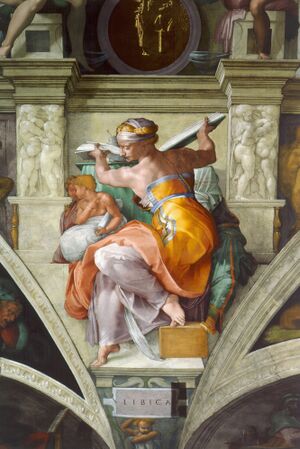سيبيل الليبية
The Libyan Sibyl, named Phemonoe, was the prophetic priestess presiding over the Oracle of Zeus-Ammon (Zeus represented with the Horns of Ammon) at Siwa Oasis in the Libyan Desert.
The term sibyl comes (via Latin) from the ancient Greek word sibylla, meaning prophetess. There were many Sibyls in the ancient world, but the Libyan Sibyl, in Classical mythology, foretold the "coming of the day when that which is hidden shall be revealed."[بحاجة لمصدر]
In Pausanias' Description of Greece, the Sibyl names her parents in her oracles:
- I am by birth half mortal, half divine;
- An immortal nymph was my mother, my father an eater of grain;
- On my mother's side of Idaean birth, but my fatherland was red
- Marpessus, sacred to the Mother, and the river Aidoneus. (Pausanias 10.12.3)
The Greeks say she was the daughter of Lamia – a daughter of Poseidon – and Zeus.[1][2] Euripides mentions the Libyan Sibyl in the prologue of the Lamia. The Greeks further state that she was the first woman to chant oracles; that she lived most of her life in Samos; and that the name Sibyl was given her by the Libyans.
Serapion, in his epic verses, says that the Sibyl, even when dead, ceased not from divination. He writes that what proceeded from her into the air after her death was what gave oracular utterances in voices and omens; and on her body being changed into earth, and the grass as natural growing out of it, whatever beasts happening to be in that place fed on it exhibited to men an accurate knowledge of futurity by their entrails. He also thinks that the face seen in the moon is her soul.[3]
Plutarch tells the story that Alexander the Great, after founding Alexandria, marched to Siwa Oasis where the Sibyl is said to have confirmed him as both a divine personage and the legitimate Pharaoh of Egypt.
الهامش
- ^ Pausanias, Guide to Greece, 10.12.1: "There is a rock rising up above the ground. On it, say the Delphians, there stood and chanted the oracles a woman, by name Herophile and surnamed Sibyl. The former Sibyl I find was as present as any; the Greeks say that she was a daughter of Zeus by Lamia, daughter of Poseidon, that she was the first woman to chant oracles, and that the name Sibyl was given her by the Libyans. [2] Herophile was younger than she was, but nevertheless she too was clearly born before the Trojan war, as she foretold in her oracles that Helen would be brought up in Sparta to be the ruin of Asia and of Europe, and that for her sake the Greeks would capture Troy. The Delians remember also a hymn this woman composed to Apollo. In her poem she calls herself not only Herophile but also Artemis, and the wedded wife of Apollo, saying too sometimes that she is his sister, and sometimes that she is his daughter." [1]
- ^ Suidas, 10th century entry on Sibylla: "Sibylla: [The daughter] of Apollon and Lamia, though according to some of [there were various other Sibylla] ... An Erythraian, because she was born in a region of Erythrai ... Some supposed her a Sicilian [Sibyl], others a Leucanian, others a Sardanan, others a Gergithian, others a Rhodian, others a Libyan, others a Samian."
- ^ Clement of Alexandria. The Stromata, or Miscellanies, Book I, Chap XV
